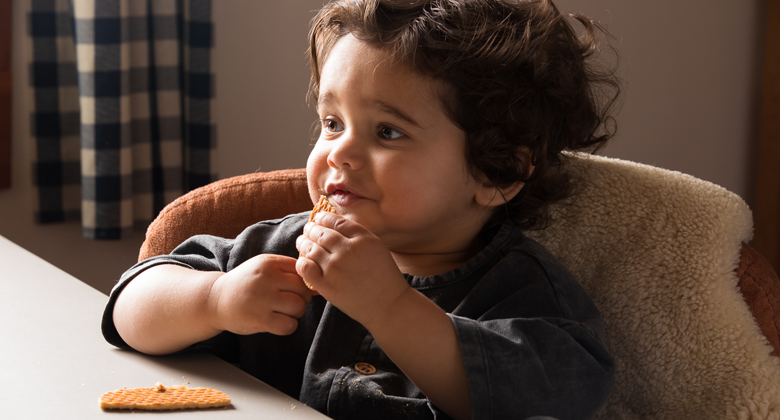Self-feeding is an important step in developing your baby's lifelong eating skills. Learn more about finger foods for baby self-feeding.

Finger foods for baby self-feeding
It’s exciting when babies start to pick up certain foods on their own. This can also be liberating for you as they begin to rely slightly less on caregiver help with mealtime. Your baby can also begin to eat some of the same foods as the rest of the family given that they’re baby-friendly.
Self-feeding helps your baby explore their autonomy and develop fine motor skills in both picking up food and bringing it to their mouth. Finger foods also help your baby practice the eating process more as they now will have to gum and chew then subconsciously learn to swallow more than liquids.
When baby can self feed
Once your baby is able to sit up independently, bring objects to their mouth, and swallow solids, you should be able to start offering finger foods. It’s best to always check with your pediatrician first for their professional guidance.
Finger foods are bite-sized pieces of soft, easy-to-chew and morsels of foods that your little one can pick up by themself. It will take some practice for them to master self-feeding with their fingers. They will need to use their pincer grasp, which is the ability to pick things up between their thumb and forefinger. This is one of the early steps toward their ability to self-feed.
Tips for self-feeding baby
Self-feeding is a wonderful milestone for both parent and baby. It can be a great way for them to explore their senses of touch, smell, and taste.
Babies get to show off their independence by raking food with their fists to learning how to pick up pieces of food between the thumb and forefinger (known as the “pincer grasp”).
For every feeding occasion, your baby should be safely seated and supervised. Small, bite-sized pieces of soft-cooked pasta, vegetables and fruits, or well-chopped pieces of cooked chicken are perfect for self-feeding. Scrambled eggs and crackers, such as saltines, are also appropriate for finger feeding. Keep the pieces small and soft to avoid any risk of choking.

Baby finger foods for self-feeding
There are certain finger foods with a soft consistency that are easier for a baby to swallow and more ideally suited for their small fingers. Some examples include:
- Small dices of well-cooked carrots
- Little cubes of avocado
- Wafer-like cracker pieces
- Well-cooked noodles
- Cereal bites
Some foods will be easier to pick up than others. Canned peaches might be too slippery for your baby to pick up at first while small bites of sweet potato will be a success. They may need a little bit of help from you in the beginning, but they will quickly learn this skill.
Avoid baby foods with choking hazards
Always consult your pediatrician before introducing solid foods and be sure to keep a close eye on your baby while they eat solids. The following foods should not be offered as they are potential choking hazards:
- Whole grapes
- Popcorn
- Hot dogs
- Raisins
- Chunks of cheese (or meat)
- Raw vegetables
- Fruit chunks, such as pear or apples
- Chunks of peanut butter
- Nuts or seeds
- Any type of hard, sticky candy
If you’re unsure about introducing a specific food, always check with your pediatrician for guidance first.
Self-feeding can help baby self-wean
Allowing your baby to self-feed can also lead to self-weaning. This is the process of your baby gradually eating more solid foods which leaves less room in their diet for milk or formula. This can be a great way to naturally allow your baby to transition fully to solid foods at their own pace.
Some finger foods like softened fruits and veggies can be less calories but take up more volume in your baby’s stomach. Be sure to monitor their weight during this transitional phase to ensure they are getting enough calories and not losing too much weight.
Utensils for self-feeding
Baby’s first utensils will be their hands and fingers. They will start out using a palmer grasp which is picking up food between all fingers and their palm in a fist. This stage can be quite messy as they learn to bring the food to their face and often drop pieces along the way or rub it on themselves as they try to get it into their mouth.
Around 9 to 12 months, your baby will likely have developed the skills to use a pincer grasp that uses their thumb and forefinger. This will allow them to pick up smaller pieces of food and hopefully lead to less mess as their self-feeding becomes more efficient.
There are also baby-friendly spoons and other utensils, usually made of soft silicone, for self-feeding that you can test with your baby around 10 months. They have thick handles to help them get a solid grip.
These utensils can help babies further develop their eating skills and hand-eye coordination as they bring them to their mouth. As this is the most advanced method, allow your baby a few months to learn and practice the required motions.

Baby finger foods delivered to your home
While self-feeding is a brilliant way to feed your baby some of the safe foods your family eats, it can also be helpful to keep some go-tos on hand in case they do not take to the flavor or texture. This allows them to still progress with independent eating and gives you time to take a few bites as well!

